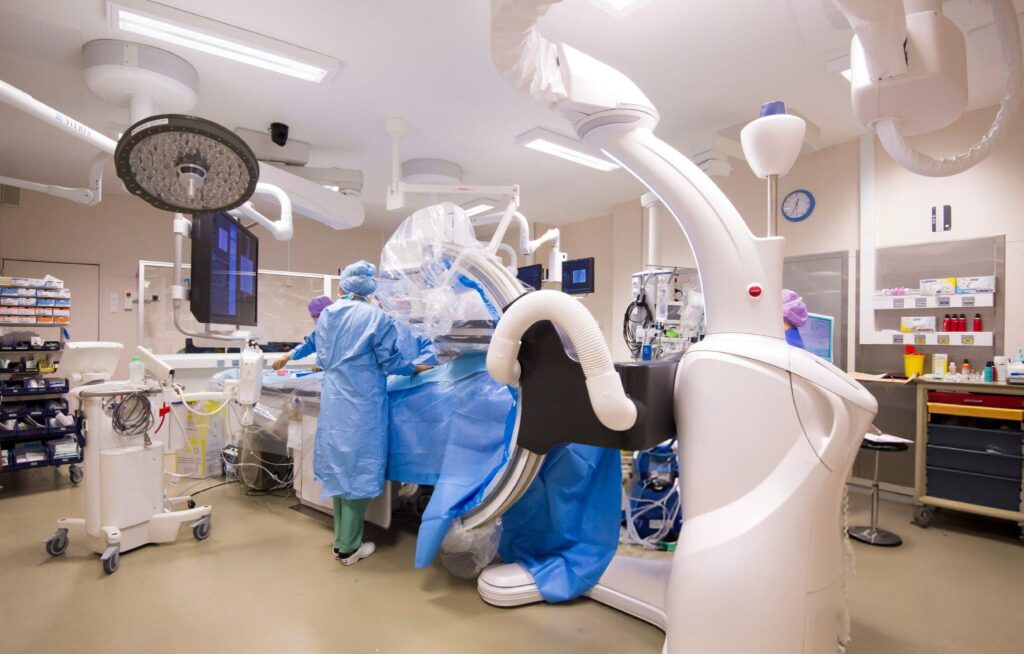Angioplasty
What is Angioplasty?
Angioplasty, also known as percutaneous coronary intervention (PCI), is a medical procedure used to open up blocked or narrowed coronary arteries (the blood vessels that supply blood to the heart) to improve blood flow. During angioplasty, a small balloon is inserted into the blocked artery through a catheter (a thin tube) and inflated to widen the artery. In many cases, a stent (a small mesh tube) is placed inside the artery to keep it open after the balloon is deflated and removed.
The procedure is typically performed in a hospital setting, often in a catheterization lab (or “cath lab”), under local anesthesia. Angioplasty is minimally invasive compared to open-heart surgery, allowing for a quicker recovery.

When is Angioplasty Required?
Angioplasty is generally required when a patient has significant blockages or narrowing in the coronary arteries, which can lead to a restricted blood supply to the heart. This restriction can cause chest pain (angina), heart attacks, or other heart-related complications. Some common situations when angioplasty may be needed include:
- Coronary Artery Disease (CAD): If a buildup of plaque (atherosclerosis) narrows the coronary arteries, reducing blood flow to the heart, angioplasty is used to reopen the artery.
- Chest Pain (Angina): When chest pain occurs due to reduced blood flow to the heart, angioplasty may be recommended to relieve symptoms and improve heart function.
- Heart Attack (Myocardial Infarction): In the case of a heart attack, when a coronary artery is suddenly blocked (often by a blood clot), angioplasty can quickly restore blood flow to the heart muscle, reducing damage.
- Severe Blockages: If a patient has severe blockages or multiple blockages in coronary arteries that cannot be treated with medication or lifestyle changes, angioplasty may be used to improve blood flow.
- High Risk of Heart Attack: In some cases, angioplasty is used as a preventive measure in people with significant blockages in their arteries who are at high risk for heart attack.
- Failed Medical Therapy: If medications or lifestyle changes are not effectively managing symptoms of heart disease, angioplasty may be considered as an option to improve blood flow and heart function.
- Stent Placement for Long-Term Support: After angioplasty, a stent is often placed to help keep the artery open, especially if the blockage is in a critical area or the artery is at high risk of closing again.
Why is Angioplasty Required?
Angioplasty is required for the following reasons:
- Restore Blood Flow to the Heart: The primary purpose of angioplasty is to restore adequate blood flow to the heart muscle when an artery is blocked or narrowed, which can reduce the risk of a heart attack or further heart damage.
- Relieve Symptoms of Angina: If chest pain (angina) is caused by narrowed arteries, angioplasty can relieve the pain by improving blood flow, allowing the heart to receive the oxygen it needs.
- Prevent a Heart Attack: By reopening blocked arteries, angioplasty can prevent or minimize damage caused by a heart attack, particularly if performed soon after the onset of symptoms.
- Improve Heart Function: Angioplasty helps improve the overall function of the heart by increasing the oxygen-rich blood supply to the heart muscle, which may improve symptoms like shortness of breath, fatigue, and dizziness.
- Minimize the Need for Surgery: Angioplasty is a less invasive alternative to open-heart surgery, allowing for a faster recovery and fewer complications.
- Reduce the Risk of Severe Complications: In cases of severe coronary artery disease, angioplasty can reduce the risk of life-threatening complications, such as arrhythmias (irregular heartbeats) or sudden cardiac arrest, which can occur when the heart is deprived of oxygen.
- Long-Term Heart Health: Angioplasty helps reduce the risk of long-term heart damage, improving quality of life, and making it possible for patients to lead more active lifestyles after the procedure.
